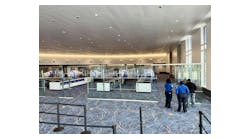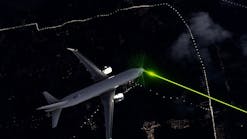Airports have the challenge of needing to communicate with all travelers across every time of day, every day of the week. As technology has evolved, the means to communicate with airline travelers has morphed with it. From static, old-fashioned print advertising to standard televisions, to LCDs, and now finally to LEDs, airports continue to look for new and better ways to deliver messaging and information to travelers.
No matter the format of the signage, airports have typically used it to communicate basic flight and baggage information, like departure information or details on which carousel a flight’s baggage will be assigned. But, the advent of LED displays is allowing airports to use digital signage for much, much more than just standard flight and baggage information. In addition to delivering information on wayfinding, LED displays are prompting signage creativity in new and exciting ways. Here are the top three trends in digital signage in airports in 2017:
1) The growth of LED displays as “digital art:” Say goodbye to the predictable rectangle. Advancements in the design of LED displays means the technology can be built in any size, any shape, and any curvature. The LEDs are no longer just information add-ons at the airport. Rather, they can be organically incorporated into an airport’s design, inserted flush in walls or hanging dramatically from ceilings. And, more and more travelers will be seeing LED displays being used as both sources of information and visual showstoppers. For example, Toronto’s airport has already embraced this trend, commissioning a giant, multi-paneled LED display in the shape of a curved flower that hangs from the ceiling of a vaulted atrium. The beauty of the display stops travelers in their tracks and is a centrally located, useful source for information.
2) Using LED displays to create interactive, immersive environments for passengers: LED displays are more than just visual instruments these days. The software uploaded into the displays, no matter whether they are built by the vendor or by a third party, can turn these devices into interactive experiences for travelers. For example, a traveler could be walking through a terminal and approach a display. As she approaches, her cell phone could latch onto the display, communicating with it her preferences and travel plans. The display is then triggered to show information relevant to her and her interests. And, the display is able to get basic information from her and every other traveler who passes it by, providing the airport and advertisers more information on their customers.
3) Combining information with additional streams of revenue: New LED displays offer airports an incredible amount of flexibility on what goes on the screen. They just aren’t limited to a laundry list of flight arrivals and departures anymore. Today’s LED screens can be segmented, so one part of the screen shows wayfinding information, another section displays typical flight arrival and departure information, and another section could show advertising. Airports can think of LED displays as a giant canvas, appropriate for attracting global advertisers, boosting sales for concessions and airport tenants, imparting information and more. By mixing the content with advertising, LED displays can help airports create an additional stream of valuable revenue. Great examples of airports already embracing this use of technology are JFK’s double-sided flight information board and Orlando’s planned massive, digital art project.
Another trend in airport signage is simplification. Facilities have felt pressured to put a lot of information on a flight information screen because the screens have typically been static. LED displays are a means for airports to simplify and streamline the data on a display because they can be customized to change content or mix in various pieces of content. Airports can seize the opportunity to strip off all of the secondary information.
LED displays also have the benefit of being great tools in emergency situations. Since modern LED displays in a vast airport can all be controlled from one central location, in times of emergencies, airports can change all of the information on all of the LED screens to reflect the nature of the emergency and instructions at the press of a button. This centralization helps airports distribute information to passengers in an efficient and omnichannel way.
With the many advances in LED displays, more and more airports will be looking to incorporate digital signage into their designs – both as functional pieces of information equipment and as dramatic, show-stopping artistic features for passenger enjoyment and experience. Combine these factors with the ability to control all signage from one central location and the allure of creating additional revenue streams for airports, and it’s no surprise that the increase in digital signage installations will be a major trend in airports in 2017.
Dan Rossborough is the Director of Strategic Accounts for NanoLumens, bringing to life digital dreams through mass customized, scalable and patented curvable digital displays created for every size and purpose, both indoor and out.




